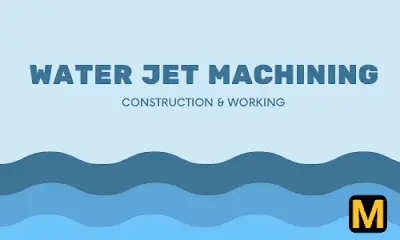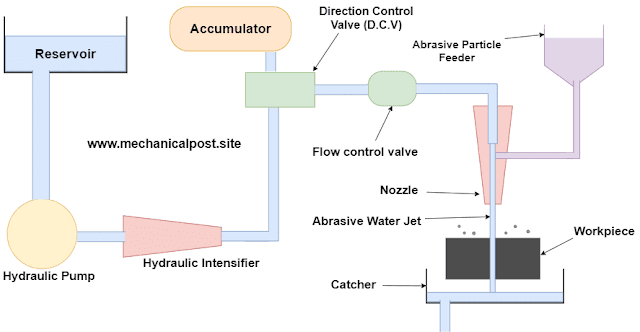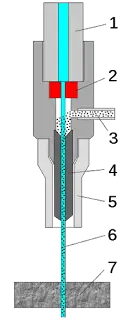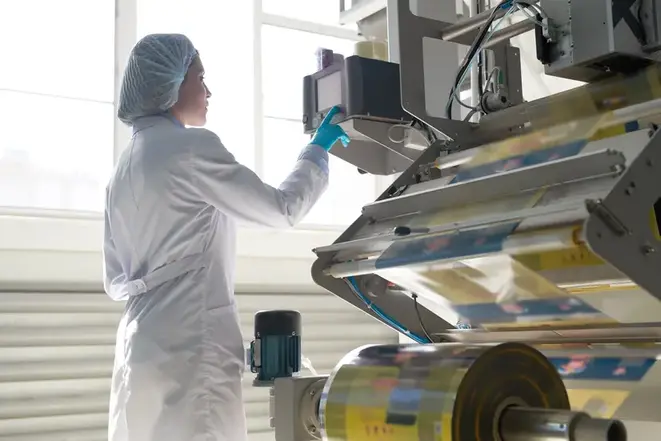Water Jet Machining: working, parts, advantages and applications with PDF
Today at The Mechanical post we’ll be looking at a type of advanced manufacturing process called “Abrasive water jet machining” and “Water Jet Machining” and the differences between the two.
Let’s begin by understanding What is water jet machining and how does it work? and after that, we’ll discuss its advantages, disadvantages, and applications.
Get your copy of the PDF on water jet machining at the end of this article. So without further ado let’s start!

What is Water Jet Machining?
Water Jet Machining (WJM) is an advanced manufacturing, non-conventional machining process wherein a high-velocity jet of water strikes the workpiece and causes its machining by erosion of the workpiece material.
In the WJM process, the pressure of the water coming out of the nozzle is in the range of 60,000 psi or 4136.85 bar.
This means that the pressure is almost 4000 times the normal atmospheric pressure (1 bar).
The simple water jet machining process is unable to machine hard materials. It can only be used for softer materials like rubber, ABS, leather, wood, plastics, etc.
So in order to machine hard materials like aluminum, steels, granite, cast iron, etc abrasive particles are mixed with the jet of water to increase the machining capability of the water jet machining process.
This process is similar to Ultrasonic machining and Abrasive jet machining which cause the machining of the workpiece by mechanical means. This machining process is paired a with CNC machine for precise and automated control.
Working principle of WJM
The water jet machining process works on the principle that when a high-velocity jet of water strikes the workpiece, machining of the workpiece takes place by erosion of the workpiece material.
The construction and working of the simple water jet machine are almost similar to its abrasive counterpart. So, let us look at the construction and working of the abrasive jet machine.
Construction of Water jet machine
The following are the main parts of the Water Jet Machining process:
- Water reservoir
- Hydraulic pump
- Hydraulic intensifier
- Accumulator
- Direction Control valve
- Flow control valve
- Mixing chamber
- Nozzle
- Abrasive particle feeder
- Catcher

Water reservoir
The water reservoir is used to store the water to be used in the water jet machining process.
Hydraulic pump
A pump is responsible for the circulation of water and is used to raise the pressure of the water from atmospheric pressure to around 5 bar before being sent to the hydraulic intensifier.
Hydraulic intensifier
This is the device responsible for creating the enormous amount of pressure that can cut through metals. The hydraulic intensifier receives the pressurized water from the pump at around 5 bar and increases it to around 4000 bar or roughly 60,000 psi.
Accumulator
The high-pressure water is stored in the accumulator and supplies to the nozzle when required. The accumulator also prevents fluctuation of water supply during the process. The accumulator of the water jet machining relies on the property of “compressibility of water” so that a uniform discharge pressure is maintained.
Direction Control valve
As the name suggests, the direction control valve is used to control the direction of water and hence control the water jet machining process.
Flow control valve
After the Direction control valve, the flow control valve is placed and is used to control the flow or speed of the water coming out of the nozzle.
Mixing chamber
It is the place where the abrasive particles are mixed with the stream of water.
Nozzle
The nozzle is a device of reducing cross-section whose function is to increase the kinetic energy of the water by converting the pressure energy in it into kinetic energy.
The nozzle increases the speed of water to supersonic speeds. Hard materials like diamond or tungsten carbide in order to prevent the erosion of the nozzle itself by the jet of water.

This is a detailed figure of the nozzle that shows the mixing of the abrasive particles with the water jet. Here, the parts shown in the figure are:
- 1: High-pressure water jet.
- 2: Hard material (ruby or diamond).
- 3: Abrasive particle (garnet).
- 4: Mixing tube.
- 5: Guard.
- 6: Cutting water jet.
- 7: Workpiece
Abrasive particle feeder
It is a hopper from where the abrasive particles are fed into. The abrasive particle feeder provides a continuous flow of abrasive particles to the stream of water.
Materials like silicon carbide, sand, aluminum oxide, etc are used as abrasives in water jet machining.
Catcher
The jet of water after being used is collected by the catcher, from where it can be reused again after proper filtration and treatment.
Working of Water jet machining
The Hydraulic pump receives water from the reservoir at atmospheric pressure and increases it to about 4-5 bar.

This water is then sent to the hydraulic intensifier which greatly increases the water pressure up to 4000 bar.
The pressurized water is then sent to the accumulator whereas a part of it is supplied to the nozzle via the control valves.
The accumulator stores the water and supplies it when needed.
The flow control valve is used to control the amount of water reaching the nozzle.
This water is then passed through the nozzle and the mixing chamber where a supersonic jet of water along with abrasive particles is created.
This jet of water then strikes the workpiece and due to the abrasive action and high-speed jet, the workpiece is machined.
The water is then collected by the catcher from where it can be reused again or disposed of safely. This is how the Water jet machining process works.
Materials that can be machined using Water jet machining
- Aluminum
- Steels
- Cast Iron
- Concrete
- Stones
- Granite
- Metal alloys
- Wood
- Leather
- Ceramics
- Plastics
- Rubber
- Glass
- Composites etc.
Applications of Water Jet machining
The applications of water jet machining include:
- Water jet machining is used in manufacturing aerospace components.
- Manufacturing of engine components.
- It is used to machine thick sheets of steel, aluminum, etc.
- It is used for drilling and cutting operations.
- Materials that are hard to machine using conventional processes.
Advantages of Water Jet machining
- High precision can be achieved in water jet machining.
- There is no need for coolant while machining.
- Complex shapes and cuts can be produced.
- A good surface finish can be obtained.
- Machined parts are dust-free as they are washed by the water jet.
- It is eco-friendly as no harmful by-products are produced.
- It has a low operation cost as compared to other non-traditional processes.
- Since water is used to machine the workpiece, there is a negligible amount of heat generated.
Disadvantages of Water Jet machining
- Very thick materials cannot be machined using water jet machining.
- High initial investment is required.
- The time required is much more when compared to traditional processes.
Check out this video by “Waterjet channel” cutting an anvil made up of cast iron into 2 pieces. Their channel is entirely based on water jet machining and you can check them out on their youtube channel cutting a variety of products using WJM.
FAQ on Water jet machining
What is the full form of WJM in advanced machining processes?
WJM stands for Water Jet Machining in advanced machining processes.
In WJM, what are the properties of jet fluid that affect the MRR?
Viscosity, flow rate, and velocity are the properties that affect the metal removal rate.
What is the key element of water jet machining for material removal?
The water jet is the key element for material removal.
How is the material removed in abrasive water jet machining?
The material is removed by erosion caused by the abrasive particles and the water jet.
What is the difference between Water jet machining (WJM) and Abrasive water jet machining (AWJM) ?
| Water Jet Machining | Abrasive water jet machining |
|---|---|
| In water jet machining the material removal is achieved only by the water jet. | In the abrasive water jet machining process, material removal is achieved by water jet as well as abrasive particles. |
| No mixing chamber is needed. | A mixing chamber is required for mixing water with abrasive particles. |
| WJM process is capable of machining soft materials like leather, wood, plastics, etc. | AWJM process is able to machine harder materials like steel, ceramics, aluminum, etc. |
| This process is comparatively cheaper. | Since abrasive particles are being used the cost of the process increases as compared to WJM. |
That’s an overview of Water jet machining. If you find this article helpful do let us know in the comments.
Like reading The Mechanical post? do join our telegram channel @themechanicalpost
We’ll be back again with yet another interesting article, till then Keep Learning!




![37 Must Have Workshop Tools & Their Uses with [PDF & Images]](https://mechanicalpost.site/wp-content/uploads/2023/07/tool-stoarge.webp)
![What is a Conveyor System? Its types, uses, advantages [with PDF]](https://mechanicalpost.site/wp-content/uploads/2022/02/What-is-conveyor-system.webp)
